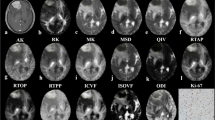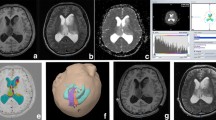Abstract
Objectives
Preoperative, noninvasive prediction of the meningioma grade is important because it influences the treatment strategy. The purpose of this study was to evaluate the role of radiomics features of postcontrast T1-weighted images (T1C), apparent diffusion coefficient (ADC), and fractional anisotropy (FA) maps, based on the entire tumor volume, in the differentiation of grades and histological subtypes of meningiomas.
Methods
One hundred thirty-six patients with pathologically diagnosed meningiomas (108 low-grade [benign], 28 high-grade [atypical and anaplastic]), who underwent T1C and diffusion tensor imaging, were included in the discovery set. The T1C image, ADC, and FA maps were analyzed to derive volume-based data of the entire tumor. Radiomics features were correlated with meningioma grades and histological subtypes. Various machine learning classifiers were trained to build classification models to predict meningioma grades. We tested the model in a validation set (58 patients; 46 low-grade; 12 high-grade).
Results
The machine learning classifiers showed variable performances depending on the machine learning algorithms. The best classification system for the prediction of meningioma grades had an area under the curve of 0.86 (95% confidence interval [CI], 0.74–0.98) in the validation set. The accuracy, sensitivity, and specificity of the best classifier were 89.7, 75.0, and 93.5% in the validation set, respectively. Various texture parameters differed significantly between fibroblastic and non-fibroblastic subtypes.
Conclusions
Radiomics feature-based machine learning classifiers of T1C images, ADC, and FA maps are useful for differentiating meningioma grades.
Key Points
• Preoperative, noninvasive differentiation of the meningioma grade is important because it influences the treatment strategy.
• Radiomics feature-based machine learning classifiers of T1C images, ADC, and FA maps are useful for differentiating meningioma grades.
• In benign meningiomas, there were significant differences in the various texture parameters between fibroblastic and non-fibroblastic meningioma subtypes.



Similar content being viewed by others
Abbreviations
- ADC:
-
Apparent diffusion coefficient
- AUC:
-
Area under the curve
- DTI:
-
Diffusion tensor imaging
- FA:
-
Fractional anisotropy
- T1C:
-
Postcontrast T1-weighted image
References
Ostrom QT, Gittleman H, Xu J et al (2016) CBTRUS statistical report: primary brain and other central nervous system tumors diagnosed in the United States in 2009–2013. Neuro Oncol 18:v1–v75
Willis J, Smith C, Ironside JW, Erridge S, Whittle IR, Everington D (2005) The accuracy of meningioma grading: a 10-year retrospective audit. Neuropathol Appl Neurobiol 31:141–149
Kshettry VR, Ostrom QT, Kruchko C, Al-Mefty O, Barnett GH, Barnholtz-Sloan JS (2015) Descriptive epidemiology of World Health Organization grades II and III intracranial meningiomas in the United States. Neuro Oncol 17:1166–1173
Modha A, Gutin PH (2005) Diagnosis and treatment of atypical and anaplastic meningiomas: a review. Neurosurgery 57:538–550
Goldbrunner R, Minniti G, Preusser M et al (2016) EANO guidelines for the diagnosis and treatment of meningiomas. Lancet Oncol 17:e383–e391
Balss J, Meyer J, Mueller W, Korshunov A, Hartmann C, von Deimling A (2008) Analysis of the IDH1 codon 132 mutation in brain tumors. Acta Neuropathol 116:597–602
Toh CH, Castillo M, Wong AM et al (2008) Differentiation between classic and atypical meningiomas with use of diffusion tensor imaging. AJNR Am J Neuroradiol 29:1630–1635
Watanabe Y, Yamasaki F, Kajiwara Y et al (2013) Preoperative histological grading of meningiomas using apparent diffusion coefficient at 3T MRI. Eur J Radiol 82:658–663
Surov A, Gottschling S, Mawrin C et al (2015) Diffusion-weighted imaging in meningioma: prediction of tumor grade and association with histopathological parameters. Transl Oncol 8:517–523
Santelli L, Ramondo G, Della Puppa A et al (2010) Diffusion-weighted imaging does not predict histological grading in meningiomas. Acta Neurochir (Wien) 152:1315–1319
Jolapara M, Kesavadas C, Radhakrishnan VV et al (2010) Role of diffusion tensor imaging in differentiating subtypes of meningiomas. J Neuroradiol 37:277–283
Sanverdi SE, Ozgen B, Oguz KK et al (2012) Is diffusion-weighted imaging useful in grading and differentiating histopathological subtypes of meningiomas? Eur J Radiol 81:2389–2395
Nagar VA, Ye JR, Ng WH et al (2008) Diffusion-weighted MR imaging: diagnosing atypical or malignant meningiomas and detecting tumor dedifferentiation. AJNR Am J Neuroradiol 29:1147–1152
Hashiba T, Hashimoto N, Maruno M et al (2006) Scoring radiologic characteristics to predict proliferative potential in meningiomas. Brain Tumor Pathol 23:49–54
Kawahara Y, Nakada M, Hayashi Y et al (2012) Prediction of high-grade meningioma by preoperative MRI assessment. J Neurooncol 108:147–152
Joo B, Han K, Choi YS et al (2018) Amide proton transfer imaging for differentiation of benign and atypical meningiomas. Eur Radiol 28:331–339
Park YW, Han K, Ahn SS et al (2018) Whole-tumor histogram and texture analyses of DTI for evaluation of IDH1-mutation and 1p/19q-codeletion status in World Health Organization grade II gliomas. AJNR Am J Neuroradiol 39:693–698
Kickingereder P, Bonekamp D, Nowosielski M et al (2016) Radiogenomics of glioblastoma: machine learning–based classification of molecular characteristics by using multiparametric and multiregional MR imaging features. Radiology 281:907–918
Kickingereder P, Burth S, Wick A et al (2016) Radiomic profiling of glioblastoma: identifying an imaging predictor of patient survival with improved performance over established clinical and radiologic risk models. Radiology 280:880–889
Kashimura H, Inoue T, Ogasawara K et al (2007) Prediction of meningioma consistency using fractional anisotropy value measured by magnetic resonance imaging. J Neurosurg 107:784–787
Louis DN, Perry A, Reifenberger G et al (2016) The 2016 World Health Organization classification of tumors of the central nervous system: a summary. Acta Neuropathol 131:803–820
Tustison NJ, Avants BB, Cook PA et al (2010) N4ITK: improved N3 bias correction. IEEE Trans Med Imaging 29:1310–1320
Shinohara RT, Sweeney EM, Goldsmith J et al (2014) Statistical normalization techniques for magnetic resonance imaging. Neuroimage Clin 6:9–19
Cha J, Kim S, Kim HJ et al (2014) Differentiation of tumor progression from pseudoprogression in patients with posttreatment glioblastoma using multiparametric histogram analysis. AJNR Am J Neuroradiol 35:1309–1317
Tang Y, Dundamadappa SK, Thangasamy S et al (2014) Correlation of apparent diffusion coefficient with Ki-67 proliferation index in grading meningioma. AJR Am J Roentgenol 202:1303–1308
Maes F, Collignon A, Vandermeulen D, Marchal G, Suetens P (1997) Multimodality image registration by maximization of mutual information. IEEE Trans Med Imaging 16:187–198
Haralick RM, Shanmugam K, Dinstein I (1973) Textural features for image classification. IEEE Trans Syst Man Cybern:610–621
Galloway MM (1975) Texture analysis using gray level run lengths. Comput Gr Image Process 4:172–179
Chawla NV, Bowyer KW, Hall LO, Kegelmeyer WP (2002) SMOTE: synthetic minority over-sampling technique. J Artif Intell Res 16:321–357
Provost F (2000) Machine learning from imbalanced data sets 101 proceedings of the AAAI’2000 workshop on imbalanced data sets, pp 1–3
Kuhn M (2008) Building predictive models in R using the caret package Caret package. J Stat Softw 28:1–26
Lunardon N, Menardi G, Torelli N (2014) ROSE: a package for binary imbalanced learning. R Journal 6(1)
Torgo L (2013) Package ‘DMwR’. Comprehensive R Archive Network
van Griethuysen JJM, Fedorov A, Parmar C et al (2017) Computational radiomics system to decode the radiographic phenotype. Cancer Res 77:e104–e107
Kollová A, Liscák R, Novotný J Jr, Vladyka V, Simonová G, Janousková L (2007) Gamma Knife surgery for benign meningioma. J Neurosurg 107:325–336
Kaur G, Sayegh ET, Larson A et al (2014) Adjuvant radiotherapy for atypical and malignant meningiomas: a systematic review. Neuro Oncol 16:628–636
Dziuk TW, Woo S, Butler EB et al (1998) Malignant meningioma: an indication for initial aggressive surgery and adjuvant radiotherapy. J Neurooncol 37:177–188
Stafford SL, Pollock BE, Foote RL et al (2001) Meningioma radiosurgery: tumor control, outcomes, and complications among 190 consecutive patients. Neurosurgery 49:1029–1038
Maclean J, Fersht N, Short S (2014) Controversies in radiotherapy for meningioma. Clin Oncol (R Coll Radiol) 26:51–64
Yan PF, Yan L, Hu TT et al (2017) The potential value of preoperative MRI texture and shape analysis in grading meningiomas: a preliminary investigation. Transl Oncol 10:570–577
Lin BJ, Chou KN, Kao HW et al (2014) Correlation between magnetic resonance imaging grading and pathological grading in meningioma. J Neurosurg 121:1201–1208
Chen TY, Lai PH, Ho JT et al (2004) Magnetic resonance imaging and diffusion-weighted images of cystic meningioma: correlating with histopathology. Clin Imaging 28:10–19
Hsu CC, Pai CY, Kao HW, Hsueh CJ, Hsu WL, Lo CP (2010) Do aggressive imaging features correlate with advanced histopathological grade in meningiomas? J Clin Neurosci 17:584–587
Nakasu S, Nakasu Y, Nakajima M, Matsuda M, Handa J (1999) Preoperative identification of meningiomas that are highly likely to recur. J Neurosurg 90:455–462
Kang D, Park JE, Kim YH et al (2018) Diffusion radiomics as a diagnostic model for atypical manifestation of primary central nervous system lymphoma: development and multicenter external validation. Neuro Oncol 20:1251–1261
Hwang WL, Marciscano AE, Niemierko A et al (2015) Imaging and extent of surgical resection predict risk of meningioma recurrence better than WHO histopathological grade. Neuro Oncol 18:863–872
New PF, Hesselink JR, O'Carroll CP, Kleinman GM (1982) Malignant meningiomas: CT and histologic criteria, including a new CT sign. AJNR Am J Neuroradiol 3:267–276
He H, Garcia EA (2009) Learning from imbalanced data. IEEE Trans Knowl Data Eng 21:1263–1284
Menardi G, Torelli N (2014) Training and assessing classification rules with imbalanced data. Data Min Knowl Disc 28:92–122
Saito T, Rehmsmeier M (2015) The precision-recall plot is more informative than the ROC plot when evaluating binary classifiers on imbalanced datasets. PLoS One 10:e0118432
Ginat DT, Mangla R, Yeaney G, Wang HZ (2010) Correlation of diffusion and perfusion MRI with Ki-67 in high-grade meningiomas. AJR Am J Roentgenol 195:1391–1395
Jothi JAA, Rajam VMA (2017) A survey on automated cancer diagnosis from histopathology images. Artif Intell Rev 48:31–81
Tropine A, Dellani PD, Glaser M et al (2007) Differentiation of fibroblastic meningiomas from other benign subtypes using diffusion tensor imaging. J Magn Reson Imaging 25:703–708
Kleihues P, Cavenee WK (2000) Pathology and genetics of tumours of the nervous system, vol 1. International Agency for Research on Cancer, Lyon
Wang S, Kim S, Zhang Y et al (2012) Determination of grade and subtype of meningiomas by using histogram analysis of diffusion-tensor imaging metrics. Radiology 262:584–592
Maeda M, Itoh S, Kimura H et al (1994) Vascularity of meningiomas and neuromas: assessment with dynamic susceptibility-contrast MR imaging. AJR Am J Roentgenol 163:181–186
Fatima K, Arooj A, Majeed H (2014) A new texture and shape based technique for improving meningioma classification. Microsc Res Tech 77:862–873
Al-Kadi OS (2010) Texture measures combination for improved meningioma classification of histopathological images. Pattern Recognit 43:2043–2053
Gatenby RA, Grove O, Gillies RJ (2013) Quantitative imaging in cancer evolution and ecology. Radiology 269:8–14
Zhang Z, Yang J, Ho A et al (2018) A predictive model for distinguishing radiation necrosis from tumour progression after gamma knife radiosurgery based on radiomic features from MR images. Eur Radiol 28:2255–2263
Funding
This research received funding from the Basic Science Research Program through the National Research Foundation of Korea (NRF) funded by the Ministry of Science, Information and Communication Technologies, and Future Planning (2017R1D1A1B03030440).
Author information
Authors and Affiliations
Corresponding author
Ethics declarations
Guarantor
The scientific guarantor of this publication is Professor Seung-Koo Lee, MD, PhD, from Yonsei University College of Medicine (slee@yuhs.ac).
Conflict of interest
The authors of this manuscript declare no relationships with any companies, whose products or services may be related to the subject matter of the article.
Statistics and biometry
One of the authors has significant statistical expertise (J.M.O., a biostatistician with 5 years of experience in computational biology).
Informed consent
The institutional review board waived the requirement to obtain informed patient consent for this retrospective study.
Ethical approval
Institutional Review Board approval was obtained.
Methodology
• Retrospective
• Diagnostic or prognostic study
• Performed at one institution
Electronic supplementary material
ESM 1
(DOCX 1884 kb)
Rights and permissions
About this article
Cite this article
Park, Y.W., Oh, J., You, S.C. et al. Radiomics and machine learning may accurately predict the grade and histological subtype in meningiomas using conventional and diffusion tensor imaging. Eur Radiol 29, 4068–4076 (2019). https://doi.org/10.1007/s00330-018-5830-3
Received:
Revised:
Accepted:
Published:
Issue Date:
DOI: https://doi.org/10.1007/s00330-018-5830-3




